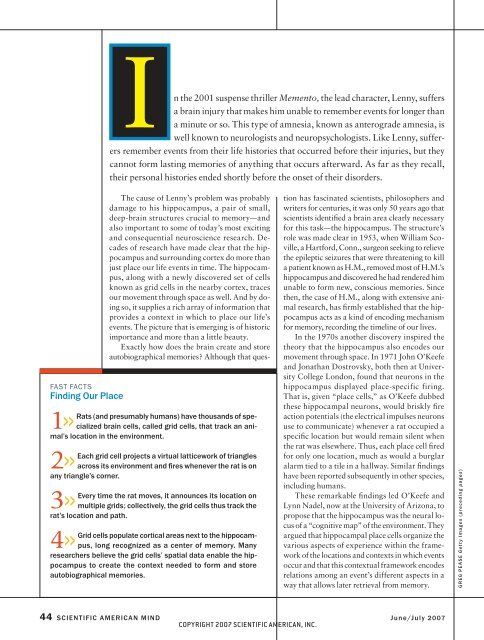Scientific American Mind-June/July 2007
Scientific American Mind-June/July 2007
Scientific American Mind-June/July 2007
You also want an ePaper? Increase the reach of your titles
YUMPU automatically turns print PDFs into web optimized ePapers that Google loves.
FAST FACTS<br />
Finding Our Place<br />
1>><br />
I n the 2001 suspense thriller Memento, the lead character, Lenny, suffers<br />
a brain injury that makes him unable to remember events for longer than<br />
a minute or so. This type of amnesia, known as anterograde amnesia, is<br />
well known to neurologists and neuropsychologists. Like Lenny, sufferers<br />
remember events from their life histories that occurred before their injuries, but they<br />
cannot form lasting memories of anything that occurs afterward. As far as they recall,<br />
their personal histories ended shortly before the onset of their disorders.<br />
The cause of Lenny’s problem was probably<br />
damage to his hippocampus, a pair of small,<br />
deep-brain structures crucial to memory—and<br />
also important to some of today’s most exciting<br />
and consequential neuroscience research. Decades<br />
of research have made clear that the hippocampus<br />
and surrounding cortex do more than<br />
just place our life events in time. The hippocampus,<br />
along with a newly discovered set of cells<br />
known as grid cells in the nearby cortex, traces<br />
our movement through space as well. And by doing<br />
so, it supplies a rich array of information that<br />
provides a context in which to place our life’s<br />
events. The picture that is emerging is of historic<br />
importance and more than a little beauty.<br />
Exactly how does the brain create and store<br />
autobiographical memories? Although that ques-<br />
Rats (and presumably humans) have thousands of specialized<br />
brain cells, called grid cells, that track an animal’s<br />
location in the environment.<br />
2>><br />
Each grid cell projects a virtual latticework of triangles<br />
across its environment and fi res whenever the rat is on<br />
any triangle’s corner.<br />
3>><br />
Every time the rat moves, it announces its location on<br />
multiple grids; collectively, the grid cells thus track the<br />
rat’s location and path.<br />
4>><br />
Grid cells populate cortical areas next to the hippocampus,<br />
long recognized as a center of memory. Many<br />
researchers believe the grid cells’ spatial data enable the hippocampus<br />
to create the context needed to form and store<br />
autobiographical memories.<br />
tion has fascinated scientists, philosophers and<br />
writers for centuries, it was only 50 years ago that<br />
scientists identifi ed a brain area clearly necessary<br />
for this task—the hippocampus. The structure’s<br />
role was made clear in 1953, when William Scoville,<br />
a Hartford, Conn., surgeon seeking to relieve<br />
the epileptic seizures that were threatening to kill<br />
a patient known as H.M., removed most of H.M.’s<br />
hippocampus and discovered he had rendered him<br />
unable to form new, conscious memories. Since<br />
then, the case of H.M., along with extensive animal<br />
research, has fi rmly established that the hippocampus<br />
acts as a kind of encoding mechanism<br />
for memory, recording the timeline of our lives.<br />
In the 1970s another discovery inspired the<br />
theory that the hippocampus also encodes our<br />
movement through space. In 1971 John O’Keefe<br />
and Jonathan Dostrovsky, both then at University<br />
College London, found that neurons in the<br />
hippocampus displayed place-specific firing.<br />
That is, given “place cells,” as O’Keefe dubbed<br />
these hippocampal neurons, would briskly fi re<br />
action potentials (the electrical impulses neurons<br />
use to communicate) whenever a rat occupied a<br />
specifi c location but would remain silent when<br />
the rat was elsewhere. Thus, each place cell fi red<br />
for only one location, much as would a burglar<br />
alarm tied to a tile in a hallway. Similar fi ndings<br />
have been reported subsequently in other species,<br />
including humans.<br />
These remarkable fi ndings led O’Keefe and<br />
Lynn Nadel, now at the University of Arizona, to<br />
propose that the hippocampus was the neural locus<br />
of a “cognitive map” of the environment. They<br />
argued that hippocampal place cells organize the<br />
various aspects of experience within the framework<br />
of the locations and contexts in which events<br />
occur and that this contextual framework encodes<br />
relations among an event’s different aspects in a<br />
way that allows later retrieval from memory.<br />
44 SCIENTIFIC AMERICAN MIND <strong>June</strong>/<strong>July</strong> <strong>2007</strong><br />
COPYRIGHT <strong>2007</strong> SCIENTIFIC AMERICAN, INC.<br />
GREG PEASE Getty Images ( preceding pages)

















